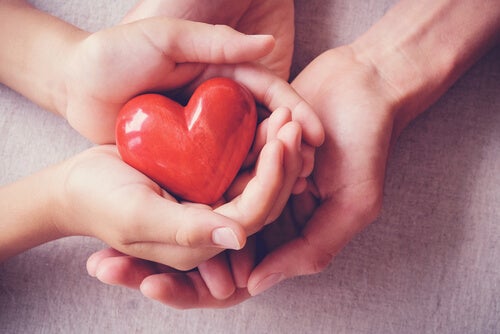The Development of Empathy in Childhood

Before explaining the development of empathy in childhood, let’s talk about the term per se. The origin of the concept “empathy” derives from what the Scottish Enlightenment called “sympathy”. David Hume, in his treatise on human nature, and Adam Smith described it as a natural means of communication.
This definition is the foundation of neuroscience, developmental psychology, and social psychology. The development of empathy in childhood yields revels very interesting facts about some evolutionary aspects of our species.
There’s one idea that stands out: our socialization isn’t the result of empathy, at least not originally. In fact, evolutionary biology tells us that altruistic behavior originated before we acquired this potential.
Some species that lack empathy exhibit such behaviors. This is the case with social insects such as bees. They die shortly after stinging a target because they sacrifice themselves to protect their community. Thus, the link between empathy and altruism isn’t simple.
The developmental psychology approach

The work of Lipps (1903) focused on the difference between the terms “sympathy” and “empathy”. Developmental psychology researchers defined empathy as a multidimensional concept that takes into account the cognitive component. Thus, it involves the recognition and understanding of other people’s emotions and the emotional component, which is related to sharing affection or an indirect response.
“If you see someone without a smile, give them one of yours.”
-Dolly Parton-
Cognitive models of empathy development
Since the 1990s, people have been studying empathy from the perspective of emotional intelligence. This is where Mayer and Salovey’s model (1997) stands out. Empathy is considered to include the perception and understanding of other people’s emotions-
Another relevant model is the Bar-On model of emotional-social intelligence (1997, 2000). This model claims that empathy is a component of a factor we refer to as interpersonal skills. That is, the ability to be aware of and understand other people’s emotions, feelings, and ideas.
These two models aren’t as integrative as the ones proposed by developmental psychology. Actually, they focus more on the cognitive component.
Recently, Batson and collaborators proposed a distinction between perspective and empathy. Gaining perspective seems to be the precursor to specifically empathic reactions (Batson et al., 1992).
Hoffman’s model on the development of empathy in childhood
Hoffman, a leading theoretician on the development of empathy in childhood, recognizes two dimensions to the study of empathy:
- The recognition of other people’s internal states.
- The indirect affectionate response.
Hoffman’s model explains how empathy begins and how it develops in children. In fact, he states that the central idea is the integration of affection and cognition that goes beyond an approach to information processing.
He argues that empathy develops in a similar way to the stages of social cognitive development. That process begins with an empathetic global feeling in which a child doesn’t have a clear distinction between themselves and others. Thus, they’re confused about the source of feelings.
From here, it progresses through several stages to the most advanced stage that combines what one achieved in previous stages. In the more advanced stages, a person can empathize with others. Mainly, by knowing that there are physical entities other than themselves and that others have internal states independent from them.
A mature level of empathy allows a person to be more influenced by the vital conditions of others rather than by an immediate situation. According to Hoffman, there must be parallelism of feelings and affections with thoughts, moral principles, and behavioral tendencies.
Stages of the development of empathy in childhood
According to Hoffman, the development of empathy from early childhood consists of four stages:
The first stage (global)
This happens during the first year of a person’s life. Here, a child still doesn’t perceive others as distinct from themselves. Thus, they confuse the pain they perceive in others as their own, just as if it was happening to them. For example, a baby who sees their mother crying might wipe their own eyes.
Another example
An 11-month-old girl saw another girl fall and began to cry. She stared at the victim for a moment, then put her thumb in her mouth and hid her face in her mother’s lap. She acts this way as it would’ve been the most common reaction if she had fallen herself.
The second stage (egocentrism)

This stage corresponds to the second year of a human’s life. Here, the child is aware that others can also experience unpleasant situations. However, they assume that the internal states of others are the same as those they experience themselves.
For instance, a 13-month-old boy who sees a sad adult may offer them his favorite doll. Another example is when a child of the same age runs to find their own mother to comfort another child who’s crying.
The third stage (other people’s feelings)
This stage lasts from the second to the third year of life. Here, a child is aware that the feelings they experience are different from other people’s. Yet, they can respond to them in an unselfish way.
During this period, a child is already in a position to understand that the intentions and needs of another person differ from theirs. Therefore, a person’s emotions may also differ from their own. Thus, they can offer comfort to others.
Fourth stage (other life conditions)
This final stage is the last period of childhood. In it, the feelings of others are perceived not only as reactions of a mere moment but also as expressions of their general life experience. That is, they respond differently to transient and chronic pain states because they take into account the general condition of others.
Before explaining the development of empathy in childhood, let’s talk about the term per se. The origin of the concept “empathy” derives from what the Scottish Enlightenment called “sympathy”. David Hume, in his treatise on human nature, and Adam Smith described it as a natural means of communication.
This definition is the foundation of neuroscience, developmental psychology, and social psychology. The development of empathy in childhood yields revels very interesting facts about some evolutionary aspects of our species.
There’s one idea that stands out: our socialization isn’t the result of empathy, at least not originally. In fact, evolutionary biology tells us that altruistic behavior originated before we acquired this potential.
Some species that lack empathy exhibit such behaviors. This is the case with social insects such as bees. They die shortly after stinging a target because they sacrifice themselves to protect their community. Thus, the link between empathy and altruism isn’t simple.
The developmental psychology approach

The work of Lipps (1903) focused on the difference between the terms “sympathy” and “empathy”. Developmental psychology researchers defined empathy as a multidimensional concept that takes into account the cognitive component. Thus, it involves the recognition and understanding of other people’s emotions and the emotional component, which is related to sharing affection or an indirect response.
“If you see someone without a smile, give them one of yours.”
-Dolly Parton-
Cognitive models of empathy development
Since the 1990s, people have been studying empathy from the perspective of emotional intelligence. This is where Mayer and Salovey’s model (1997) stands out. Empathy is considered to include the perception and understanding of other people’s emotions-
Another relevant model is the Bar-On model of emotional-social intelligence (1997, 2000). This model claims that empathy is a component of a factor we refer to as interpersonal skills. That is, the ability to be aware of and understand other people’s emotions, feelings, and ideas.
These two models aren’t as integrative as the ones proposed by developmental psychology. Actually, they focus more on the cognitive component.
Recently, Batson and collaborators proposed a distinction between perspective and empathy. Gaining perspective seems to be the precursor to specifically empathic reactions (Batson et al., 1992).
Hoffman’s model on the development of empathy in childhood
Hoffman, a leading theoretician on the development of empathy in childhood, recognizes two dimensions to the study of empathy:
- The recognition of other people’s internal states.
- The indirect affectionate response.
Hoffman’s model explains how empathy begins and how it develops in children. In fact, he states that the central idea is the integration of affection and cognition that goes beyond an approach to information processing.
He argues that empathy develops in a similar way to the stages of social cognitive development. That process begins with an empathetic global feeling in which a child doesn’t have a clear distinction between themselves and others. Thus, they’re confused about the source of feelings.
From here, it progresses through several stages to the most advanced stage that combines what one achieved in previous stages. In the more advanced stages, a person can empathize with others. Mainly, by knowing that there are physical entities other than themselves and that others have internal states independent from them.
A mature level of empathy allows a person to be more influenced by the vital conditions of others rather than by an immediate situation. According to Hoffman, there must be parallelism of feelings and affections with thoughts, moral principles, and behavioral tendencies.
Stages of the development of empathy in childhood
According to Hoffman, the development of empathy from early childhood consists of four stages:
The first stage (global)
This happens during the first year of a person’s life. Here, a child still doesn’t perceive others as distinct from themselves. Thus, they confuse the pain they perceive in others as their own, just as if it was happening to them. For example, a baby who sees their mother crying might wipe their own eyes.
Another example
An 11-month-old girl saw another girl fall and began to cry. She stared at the victim for a moment, then put her thumb in her mouth and hid her face in her mother’s lap. She acts this way as it would’ve been the most common reaction if she had fallen herself.
The second stage (egocentrism)

This stage corresponds to the second year of a human’s life. Here, the child is aware that others can also experience unpleasant situations. However, they assume that the internal states of others are the same as those they experience themselves.
For instance, a 13-month-old boy who sees a sad adult may offer them his favorite doll. Another example is when a child of the same age runs to find their own mother to comfort another child who’s crying.
The third stage (other people’s feelings)
This stage lasts from the second to the third year of life. Here, a child is aware that the feelings they experience are different from other people’s. Yet, they can respond to them in an unselfish way.
During this period, a child is already in a position to understand that the intentions and needs of another person differ from theirs. Therefore, a person’s emotions may also differ from their own. Thus, they can offer comfort to others.
Fourth stage (other life conditions)
This final stage is the last period of childhood. In it, the feelings of others are perceived not only as reactions of a mere moment but also as expressions of their general life experience. That is, they respond differently to transient and chronic pain states because they take into account the general condition of others.
All cited sources were thoroughly reviewed by our team to ensure their quality, reliability, currency, and validity. The bibliography of this article was considered reliable and of academic or scientific accuracy.
- Barnet, M.A. (1992). Empatía y respuestas afines en los niños. En Eisenberg, N. & Strayer, J. (Eds.), La empatía y su desarrollo (pp. 163-180). Bilbao: Desclée de Brouwer.
- Eisenberg, N. & Strayer, J. (Eds.). (1987). Empathy and its development. Cambridge, UK: Cambridge University Press.
- Mayer, J. D. & Salovey, P. (1997). What is Emotional Intelligence? En Salovey, P. & Sluyter, D. (Eds.), Emotional development and emotional intelligence: Educational implications (pp. 3-31). Nueva York: Basic Books.
This text is provided for informational purposes only and does not replace consultation with a professional. If in doubt, consult your specialist.







